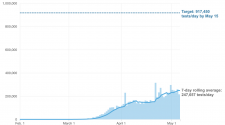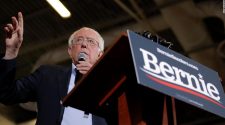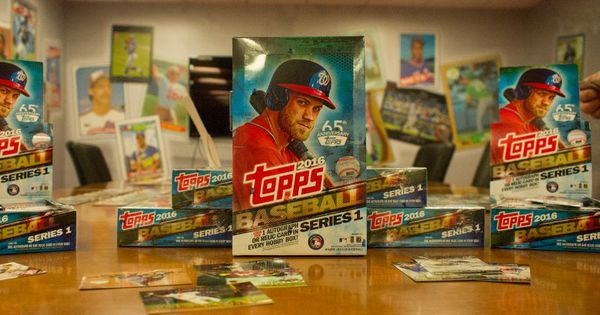NEW YORK, NY – FEBRUARY 10: Topps’ baseball cards from the 2016 season are on display during the … [+]
Once present at every deli, gas station and department store, baseball cards have found a resurgence online. Instagram albums and live YouTube box breaks have replaced baseball cards shops and card shows. Author Eric Moskowitz details navigating a new community of dealers and collectors in his Atlantic article, “How Baseball Cards Got Weird.”
“I was born in the late ’70s and grew up in what we now think of as a junk wax era when people were totally crazy about baseball cards,” Moskowitz said on the Baseball Happenings Podcast. “You could not go into a 7-Eleven, supermarket or a greeting card store without finding all of the rack packs and wax pack boxes crowded by the register.”
“It’s easier to find actual major leaguers in my neighborhood than it is finding their cards.”
Imagine Moskowitz’s surprise when he could not find one pack in his baseball crazed Washington Heights neighborhood. He said you were more likely to run into David Ortiz getting a shape-up than spot a Topps logo at the legion of street corner bodegas.
“I live in Washington Heights, which is a baseball epicenter of New York City,” he said. “Around Father’s Day, somebody asked us, ‘Does anyone know where I can buy some baseball cards?’ And it was like crickets. Nobody knew.
“You used to be able to walk out your door and find cards anywhere—even street vendors on the sidewalk. That’s all gone in our neighborhood here. There’s a barbershop where like every Dominican player on a visiting team goes when they’re here to play the Yankees or the Mets. They get their hair cut at the Jordan MVP barbershop on 189th and Broadway. So, it’s easier to find actual major leaguers in my neighborhood than it is finding their cards. I could not have imagined that scenario as a kid.”
Now in his early 40s, Moskowitz sampled new baseball cards digitally on his way back into the hobby. He got his feet wet by watching various baseball card dealers known as “breakers” who live stream opening their products. Customers buy into slots (teams, players, etc.), and the breakers do the sorting. From the confines of his home, Moskowitz discovered his new baseball card store with Gargoyle Card Breaks. He bonded with their owner Billy Byington and his customers through chat room discussions.
“When I found Billy’s break at Gargoyle, it was very clear he had a community,” he said. “I was very transparent. I told people that I’m here as a collector coming back after 25 years, but I’m also working on a magazine piece about the state of cards. Everybody sort of jumped into the chat saying, ‘Oh man, you’re so lucky you found Billy. His prices are fair, he’s a great guy and you will see the same people come back every night. And it’s not just because we’re obsessive addicts, but because they have a great rapport.’”
As Moskowitz developed a feel for this new voyeuristic collecting world, he found traditional set cards (also called base cards) became this era’s junk wax. Loose packs at local shops, shows, and national retailers were tagged as the hobby’s third rail as consumers searched for a less tainted buying experience.
“What I learned that day is the pack has become radioactive,” he said. “The pack used to be the essential building block of card collecting. You got a pack of cards, originally probably a dozen or 15 [cards] and a stick of gum. “Now even at the low end, you’re guaranteed to get one, two or three autographs, a relic or a serial-numbered card in a box. Nobody wants a straight pack. They want a chance of getting a fresh box or case to make sure they’re not getting the warmed-over leftovers after somebody found the big hit from a box.”
With high-value inserts buried throughout cases across the country, earnest collectors vie to pull one of these rarities. As the stakes have skyrocketed, sports cards have attracted attention from investors such as entrepreneur Gary Vaynerchuk. Topps captured Vaynerchuk’s hobby involvement in a series of sets earlier this year. Moskowitz visited Gary Vee to get his pulse on collecting’s re-emergence.
“He thinks short of an economic crash, that this has not yet crossed over into something that is sort of universally cool, or totally mainstream yet,” he said. “It’s still coming back, and he thinks the white-hot moment is still a year away.”
Moskowitz urges one to use a sense of caution, especially when looking at their cards as an investment. He likens the rise of curious investors dipping their toes into the card market to those who jumped into cryptocurrency a short while ago.
“It makes you think a little bit of that Bitcoin moment,” he said. “People who were throwing their money at crypto were maybe people who didn’t have it to lose. … I think something like cards [is] obviously volatile, and anyone who is getting into cards as a primary investment is taking a big risk.”
His Atlantic piece supplied a fresh outsider perspective, vocalizing someone peering around the hobby’s edges looking for a comfortable entry point. Thumbing through his new acquisitions, Moskowitz resonated in his rediscovered enjoyment.
“I think that they’re fun,” he said. “I had kind of forgotten how much I loved it, and I’ve gotten totally hooked again. I would be lying if I said I wasn’t excited if I got a card that was worth something, but I wouldn’t advise it as a retirement plan. On the other hand … the trends are that as part of this comeback, card values have been going up again.”

















